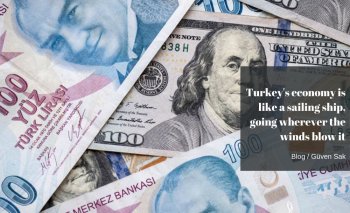Commentaries
Fatih Özatay, PhD - [Archive]
Drops in interest and exchange rates: What do they indicate? 06/08/2009 - Viewed 1760 times
We also saw this after the 2001 crisis. Exchange rate that started to rise continuously after the crisis began to fall down with the last months of the year. With the termination of the political ambiguity of the second half of 2000 and the Iraqi war in the early 2003; the decrease in exchange rate become evident and substantial number of people and particularly exporters started to complain about the appreciation of Turkish lira.
Recently, both interest rate and exchange rate have been decreasing. On Tuesday news signaled that the historic-low auction interest rate was recorded. Favorable indicators do not end here. Good news arrives from all around the world. Yesterday, a statement that Brazil's economy has been recovering from the recession was made. It is argued that recovery has begun in the USA. The only matter of discussion is how long will the recovery take. What is going on? Are things turning around?
Let us get back to post-2001 crisis period. What do you see? A strong program: After years, banking sector was being discussed in detail. There existed a highly ambitious budget discipline and monetary discipline; structural reform schedule; and strong IMF and World Bank support. The level of monetary support increases substantially in particular after September 11 attacks. Taking into consideration this highly strong economic policy framework, Central Bank publishes announcements indicating that in such a climate, Turkish lira will tend to appreciate; foreign exchange (FX) demand will gradually decrease while FX supply will gradually increase. After drawing attention to these potential developments, the Bank announces that it can launch FX purchase auctions to strengthen its FX reserves. And the Bank actually does so. Global cycles also help except for in 2004 and 2006. Interest rate and exchange rate drops appearing in this context show that things are going well. It indicates that the implemented program works. However, the same cannot be said for the current state of affairs: There is no economic policy framework lying in the basis of the appreciation trend of lira or the fall in interest rates. Apart from monetary policy, there is no economic policy with definite targets and credible perspective for the medium term where it is more or less predictable what can be done under which conditions, and where policy tools are clearly defined. So, what happens as a result?
For some time now, Central Bank has been stating that policy interest rates will have a downwards trend. This make it possible to purchase treasury bills at low prices (high interests) today and to sell at high prices (low interests) tomorrow. It produces a considerable opportunity for making profits therefore, demand for T-bills increase. It becomes profitable to convert FX into Turkish lira and purchase T-bills. This is one reason for the drops in exchange and interest rates.
Second reason connected with the first is that interest rates in foreign markets are quite low. Reduction of ambiguities about global financial system raised back risk appetite. Through interest rates tend to fall in Turkey and in countries like Turkey, they are quite higher compared to developed countries. And this increases the demand for Turkey's T-bills.
Third, in a climate where domestic demand is quite low, firms' demand for credit is considerably low. Downward trend for bank credits stopped; but credit stock does not rise either since March. For banks, it becomes more meaningful to hold more T-bills. And this increases demand for bills and decreases bill prices.
Fourth, with the reduction in external financing opportunities and the rise in costs, a part of the corporate sector most probably started to finance a certain proportion of their debt with internal financing. The source for this might be wealth kept abroad. And this means that FX flows into the economy through different channels; having a role in the downward pressure on exchange rate.
So, which of these reasons is the fruit of a healthy economic policy? Though it is a right decision, what is the main reason behind the interest rate cutting policy of the Central Bank? These reasons are that domestic demand has come to a halt; economic contraction and low commodity prices in international markets. First two is a result of the fact that we failed to develop a policy to tackle the crisis, and the last is a result of the global crisis. Isn't it?
From this angle, I cannot be optimistic. If you say that would it be better if economic contraction would be coupled with high levels of interest and exchange rates? You are right; it would not be better. I just try to identify correctly the reasons behind the current course of affairs.
This commentary was published in Radikal daily on 06.08.2009














